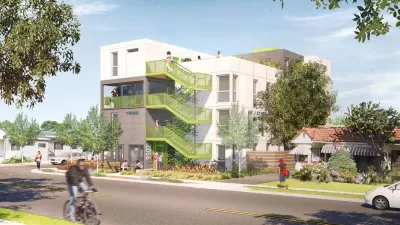Six years after Prop HHH was passed, the fund appears to be delivering on its housing construction goals in the 10-year timeline. But the measure is being routinely criticized on all sides.

Proposition HHH was drafted by the Los Angeles City Council and put before voters in November 2016. The $1.2 billion housing bond promised to fund up to 10,000 units of new permanent supportive housing and affordable housing over 10 years to help get people from the streets and shelters into stable homes.
The money was to come from a new tax on property owners. It was a big ask: Since it involved taxation, the ballot measure needed a two-thirds majority to pass. Voters approved it with 77 percent of the vote, a sign that Angelenos wanted to see solutions to rising homelessness in the city.
Now, six years later, even though the HHH fund appears to be delivering on its housing construction goals in the 10-year timeline, the measure is being routinely criticized by elected officials, candidates in the 2022 mayoral race, and the city controller for delays, rising costs, and being an inadequate fix to the homelessness crisis in Los Angeles. In the Los Angeles mayoral primary this spring, when homelessness was one of the top issues, some candidates even suggested HHH money be clawed back or diverted to more immediate emergency shelters. What happened?
On Target
According to an HHH tracker from the city’s housing department (a similar tracker on Mayor Eric Garcetti’s website has been broken for months), there are 125 projects in the “HHH pipeline,” for a total of 7,913 units. This includes those in pre-development or development, as well as those completed and opened. Although all 125 projects are expected to be done by the end of the 10-year plan, only roughly 27 are open now; 67 are in construction, 30 in pre-development, and the loan recently closed on one project.
HHH’s benefits can extend beyond the direct funding it provides. It can make getting other financing easier as well...
FULL STORY: Did LA’s Supportive Housing Bond Fail?

Planetizen Federal Action Tracker
A weekly monitor of how Trump’s orders and actions are impacting planners and planning in America.

Maui's Vacation Rental Debate Turns Ugly
Verbal attacks, misinformation campaigns and fistfights plague a high-stakes debate to convert thousands of vacation rentals into long-term housing.

San Francisco Suspends Traffic Calming Amidst Record Deaths
Citing “a challenging fiscal landscape,” the city will cease the program on the heels of 42 traffic deaths, including 24 pedestrians.

Amtrak Rolls Out New Orleans to Alabama “Mardi Gras” Train
The new service will operate morning and evening departures between Mobile and New Orleans.

The Subversive Car-Free Guide to Trump's Great American Road Trip
Car-free ways to access Chicagoland’s best tourist attractions.

San Antonio and Austin are Fusing Into one Massive Megaregion
The region spanning the two central Texas cities is growing fast, posing challenges for local infrastructure and water supplies.
Urban Design for Planners 1: Software Tools
This six-course series explores essential urban design concepts using open source software and equips planners with the tools they need to participate fully in the urban design process.
Planning for Universal Design
Learn the tools for implementing Universal Design in planning regulations.
Heyer Gruel & Associates PA
JM Goldson LLC
Custer County Colorado
City of Camden Redevelopment Agency
City of Astoria
Transportation Research & Education Center (TREC) at Portland State University
Jefferson Parish Government
Camden Redevelopment Agency
City of Claremont





























